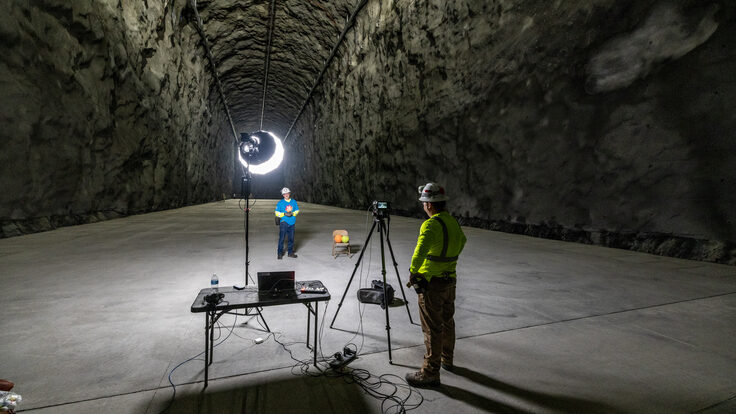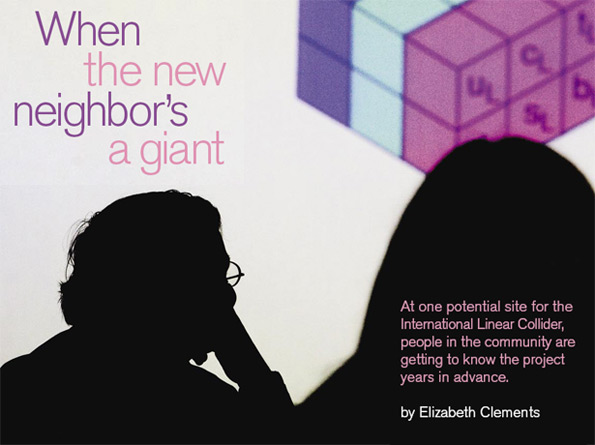 |
| Photos: Reidar Hahn, Fermilab |
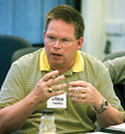 |
"Is your science supporting enough young talent to carry the project along the way?" —Mike Herlihy |
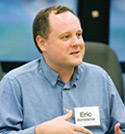 |
"In validating your theories, what kinds of things are currently anticipated that could radically shift this whole process?" —Eric Schwarze |
Mike Herlihy is active in the village of North Aurora, near Fermi National Accelerator Laboratory and west of Chicago. Hes been a village trustee for six years, belongs to the Lions Club and served on an advisory committee to evaluate a proposed freeway. As a principal in a roofing company with a background in civil engineering, hes particularly familiar with construction and how it can affect a community.
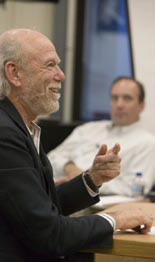 |
| The Citizens' Task Force toured Fermilab and met with Barry Barish, above, head of the global effort to design the ILC. |
So when he read about a proposal to build the International Linear Collider (ILC), a 20-mile-long particle accelerator, near his community, Herlihy took action. He was not alone. Herlihy volunteered to serve on Fermilabs ILC Citizens Task Force, a group of 25 community leaders charged with identifying concerns about the possible project—from the way it would look to its potential economic impact on the region—years before it could become a reality.
On April 30, during its monthly meeting in Fermilabs Wilson Hall, the group had the opportunity to pick the brain of Barry Barish, the California Institute of Technology physicist leading the worldwide effort to design and build the next-generation machine. Members grabbed cookies by the door, filed into the usual 11th floor meeting room and absorbed Barishs description of the ILC.
Barish started with the big questions about the universe and told the tale of how the ILC came to be—a history that stretches back more than two decades, when scientists first envisioned an earlier design known as the Next Linear Collider. "When you work on a project that lasts many years, its interesting the whole way," he said.
For Herlihy, the conversation with Barish added a completely different flavor to the project, opening his eyes to the driving passion behind the ILC.
"I have a paradigm vision of what a scientist is like, and he painted a much different picture," Herlihy says. "He didnt get embroiled in the facts but instead was challenged by a broader, greater vision."
The next big physics machine
A vision indeed. As proposed by the particle physics community, the ILC would be roughly 20 miles long and 300 feet below ground. It would contain approximately 16,000 superconducting cavities, 13,000 magnets, and 2000 cryomodules—a shopping list that, supporters say, would boost worldwide industry and lead to further technological advancements. As the worlds largest and most complicated slingshot, the accelerator would hurl electrons and their opposites, positrons, toward each other at nearly the speed of light. The resulting collisions could reveal the makeup of the dark matter and dark energy that constitute 96 percent of the universe, leaving just 4 percent for familiar, ordinary matter.
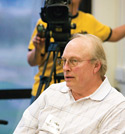 |
"What are the factors in determining the site? What body makes the decision?" —Charles McCormick |
Nearly 1000 scientists around the world are contributing to the design of the ILC. A global research plan is under development; the design team hopes to begin picking a site by 2011, and start construction as soon as 2012. If the United States decides to submit a bid to host the collider, the Department of Energy has expressed interested in building it at Fermilab.
With 10 square miles of land, Fermilab has plenty of room for its resident herd of roaming buffalo but not enough for the 20-mile-long ILC. While the main operations, such as the detectors and beam sources, would be on the Fermilab site, the tunnel would extend well beyond the labs boundaries. Several access shafts, each roughly 30 feet in diameter, would be located off site, along with a number of buildings needed for cryogenic equipment and other instrumentation—some as large as a "big box" store, such as Target.
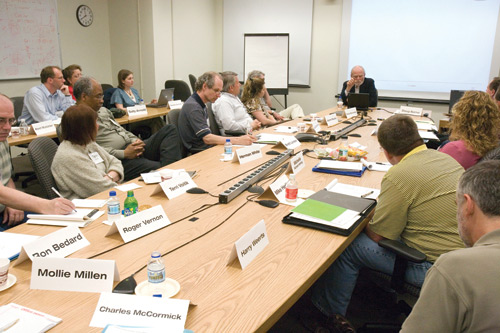 |
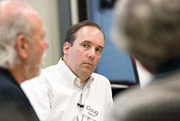 |
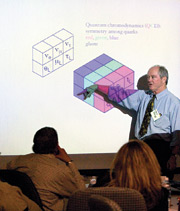 |
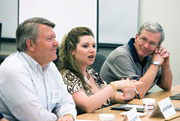 |
| Top: Facilitator Doug Sarno. Middle: Fermilab theorist Chris Quigg illustrates basic concepts of collider physics with a slide show. Bottom: Task Force members Joe Suchecki (left), Jayme Muenz and David Brummel. |
Plenty of volunteers
When Fermilab sought nominations for the ILC Citizens Task Force late last year, it was inundated with responses. Twenty-five people were selected, ranging from a mayor to an environmentalist and a school superintendent, representing a broad range of perspectives and interests. "We want this panel to look and think like the region," says Doug Sarno of the Perspectives Group, a consulting firm that specializes in public participation, who is facilitating the meetings. "This is a really critical piece of the puzzle for us, to understand how this region will look at and think about the ILC."
No matter where the ILC ends up—countries in Europe and Asia have also expressed an interest in hosting it—the lessons learned from Fermilabs task force may well apply to those regions as well, which is one reason Barish is cultivating a dialogue with potential neighbors now.
For Barish, whose average day might include meeting with world scientific leaders, presenting proposals to funding agencies, lecturing at institutions or even receiving an honorary degree, as he did from the University of Florida in May, it was an unusual experience. Meeting with the Fermilab task force gave him an opportunity to learn from another group of people with a big stake in the outcome of the project, one whose voices may ultimately be the loudest of all.
Fermilab first experienced the powerful influence of its local community in the 1980s when the Department of Energy proposed Fermilab as a possible site for the Superconducting Super Collider, a 54-mile oval-shaped accelerator. A local citizens group called CATCH, or Citizens Against the Collider Here, spearheaded community opposition to the project. Eventually a site in Texas was selected; however, the project was shut down before construction was finished.
So meeting with the community early on "is very healthy, independent of where the ILC gets sited," Barish says. "It is not as formal as talking to the funding agencies, where everyone wears a certain hat and has an agenda. The task force members each have their own identities too, but they took off their hats for this meeting and that really made this a different kind of conversation."
Going to boot camp
The task forces first order of business has been to get the information it needs to weigh in on the pertinent issues. The members have been going to particle physics boot camp, a crash course on everything they ever wanted to know about the ILC, including how the machine works and why the scientific community wants to build it. The groups meeting with Barish was the last step in that education.
Much to Barishs surprise, the members did not ask him to justify the high cost of the project or explain why it is so important. Instead, they focused on the science: Why does the accelerator have to be linear rather than circular, like the labs Tevatron collider? Why smash electrons? What happens after the ILC?
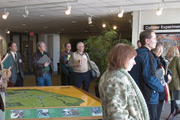 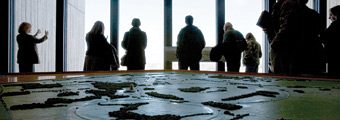 |
| Above, task force members gaze out over the Fermilab grounds, a potential site for the big collider. The 20-mile-long collider would extend beyond the labs boundaries, and community support is essential. |
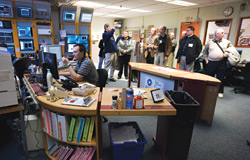 |
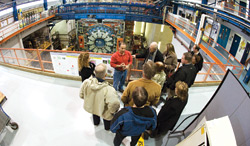 |
Warrenville mayor David Brummel asked, "Is there a precedent for the way this is going to happen? Do we have anything that is already working at this level or will it all have to be created?"
Barish responded that there is another large accelerator, the Large Hadron Collider, about to open at CERN, the European particle physics lab near Geneva. "It is not completely global," he said, "but it is quite international in participation. But establishing an international project isnt the biggest problem, to be honest with you. The big worry is how do we put together an international management while simultaneously doing the R&D?"
Members of the task force say they were surprised by the sheer intrigue of the science. For some, learning that only four percent of the universe consists of ordinary matter was mind-boggling. For others, the marriage between science and technology was most exciting. "What has amazed me the most so far is that these scientists believe that leading with the wonder of physics is the best way to make people care," says Eric Schwarze, an administrator and lecturer at Aurora University. "I think you are starting to convert me on that."
The scientific case for building the ILC may be enough to inspire, but the task force is just beginning to sink its teeth into some of the trickier issues, such as property rights, environmental protection, and safety. One concern it has already raised is the time-frame for building the ILC. By the end of this decade, the scientific community hopes to be in talks with governments around the world about siting, building and paying for the collider. According to this time-frame, major construction would occur over a period of seven years and scientific operations would begin around 2019. However, obtaining international agreements, making funding arrangements and selecting a site could delay the project by several years.
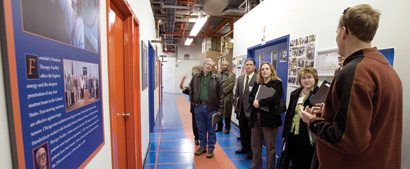 |
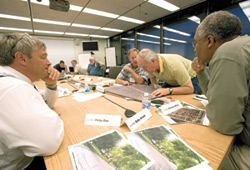 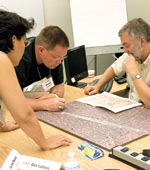 |
| The task force represents a broad range of people in the community, from a school superintendent to a mayor, an environmentalist and a principal in a roofing firm. Theyll meet through the end of this year. |
A long timeline
"It is so far out there," said task force member Joe Suchecki, director of public affairs for the Engine Manufacturers Association in Chicago. "If it is that far away, what does that mean for Fermilab? Will the task force have to start all over again?"
Herlihy raised a concern about the timeline that he can personally relate to—manpower. "Im in the roofing business, and ten years from now, we will be going through a wave of retirements," he says. "This is a real challenge for us. Is your science supporting enough young talent to carry the project along the way?"
Barish responded, "We have to worry about manpower, and its a concern. There is the talent to do it but it will take good leadership to make sure we have the skills we need. It is a very good question, and there is no real answer."
The task force will continue to meet through the rest of the year, weighing in on such things as the orientation of the machine, where the underground tunnel, buildings and other structures might be located and how the communitys role in Fermilabs long-term mission can be strengthened. Then it will discuss what the next steps should be.
"I may not be able to draw the physics on a whiteboard, but I understand so much better the intrigue—what is motivating the science and the need for the machine," Herlihy says. "Now we are ready to transition into the elements that we can relate to in our community."
Click here to download the pdf version of this article.




